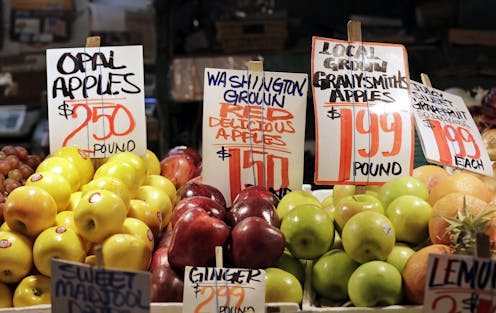Inflation is healthy for the economy – but too much can trigger a recession, while too little means
The Fed is in a tricky position as it mulls cutting interest rates to boost the economy, which also risks spurring runaway inflation and an economic downturn.

In a healthy economy, prices tend to go up – a process called inflation.
While you might not like that as a consumer, moderate price growth is a sign of a healthy, growing economy. And, historically at least, wages tend to go up at about the same pace during periods of inflation.
The U.S. Federal Reserve sees 2% inflation as the sweet spot for the economy, which is about its current level. But some economists, including those at the Fed, worry the economy is weakening, which would cause inflation to drop below its target – something it wants to avoid. The latest data, out June 12, suggested this may be happening.
As a result, there’s growing speculation that the Fed will cut interest rates to give the economy a boost, which would indirectly spur more inflation. The problem is, too much inflation can also be a bad thing.
I’ve been studying how inflation affects markets for many years. Let me explain what it is – and why the Fed has a tough job ahead.
What is inflation?
Inflation is defined as the rate of change in the prices of everything from a bar of Ivory soap to the cost of an eye exam.
In the U.S., the most commonly used measure of inflation is based on something called the consumer price index. Simply put, the index is the average price of a basket of goods and services that households typically purchase. It’s often used to determine pay raises or to adjust benefits for retirees. The year-over-year change is what we call the inflation rate.
The current change in the index is around 2%. But this is an average across a range of categories. For example, over the last year, the price of tobacco products went up 4.6%, while the pricing of apparel actually fell 3%. Clearly, the actual change in cost of living will vary from person to person depending on how they spend their money.
The latest data from the Department of Labor showed a closely watched measure of inflation was lower than expected in May, a worrying sign that the economy may be growing too slowly.
A moderate amount of inflation is generally considered to be a sign of a healthy economy, because as the economy grows, demand for stuff increases. This increase in demand pushes prices a little higher as suppliers try to create more of the thing that consumers and businesses want to buy. Workers benefit because this economic growth drives an increase in demand for labor, and as a result, wages usually increase.
Finally, these workers with higher wages go out and buy more stuff, and so this “virtuous” cycle continues. Inflation isn’t really causing all this to happen – it is merely the symptom of a healthy, growing economy.
But when inflation is too low – or too high – a “vicious” cycle can take its place.
Why low inflation is bad
Very low inflation usually signals demand for goods and services is lower than it should be, and this tends to slow economic growth and depress wages. This low demand can even lead to a recession with increases in unemployment – as we saw a decade ago during the Great Recession.
Deflation, or falling prices, is particularly bad. When prices are decreasing, consumers will delay purchases. For example, why buy a new washing machine today if you could wait a few months to get it cheaper?
Deflation also discourages lending because it leads to lower interest rates. Lenders typically don’t want to lend money at rates that give them a very small return.
Fortunately, deflation is rare in developed economies.
And too much can be even worse
But getting the balance right isn’t easy. Too much inflation can cause the same problems as low inflation.
If left unchecked, inflation could spike, which would likely cause the economy to slow down quickly and unemployment to increase. The combination of rising inflation and unemployment is called “stagflation,” and is feared by economists, central bankers and pretty much everyone else. It’s what can cause an economic boom to suddenly turn to bust, as Americans saw in the late 1970s.
The Fed managed to reduce inflation to normal levels only after driving up short-term interest rates to a record 20% in 1979.

A balancing act
So returning to the current situation, the Fed has to tread carefully.
Cutting interest rates now should boost the U.S. economy but risks driving up inflation beyond “healthy” levels. If the Fed does nothing, inflation may fall as economic growth slows. Either path could lead to recession.
This is why the Fed is typically very cautious.
This article contains elements of a story originally published on Feb. 14, 2018.
Richard S. Warr does not work for, consult, own shares in or receive funding from any company or organization that would benefit from this article, and has disclosed no relevant affiliations beyond their academic appointment.
Read These Next
Midlife weight gain can start long before menopause – but you can take steps early on to help your b
What you do in the years leading up to menopause can help counter the natural hormonal effects of aging,…
How the ‘slayer rule’ might play a role in determining who will inherit wealth from Rob Reiner and h
These rules have a long history in the United States. They played a role in the notorious murders by…
From truce in the trenches to cocktails at the consulate: How Christmas diplomacy seeks to exploit s
World leaders like to talk up peace at Christmastime. But alongside the tales of seasonal breaks in…






